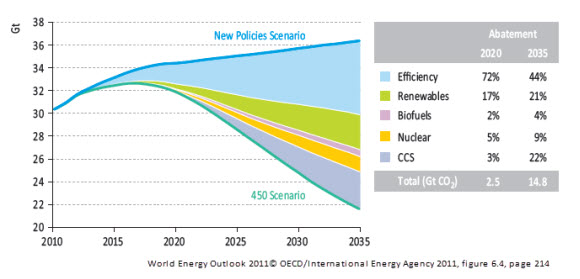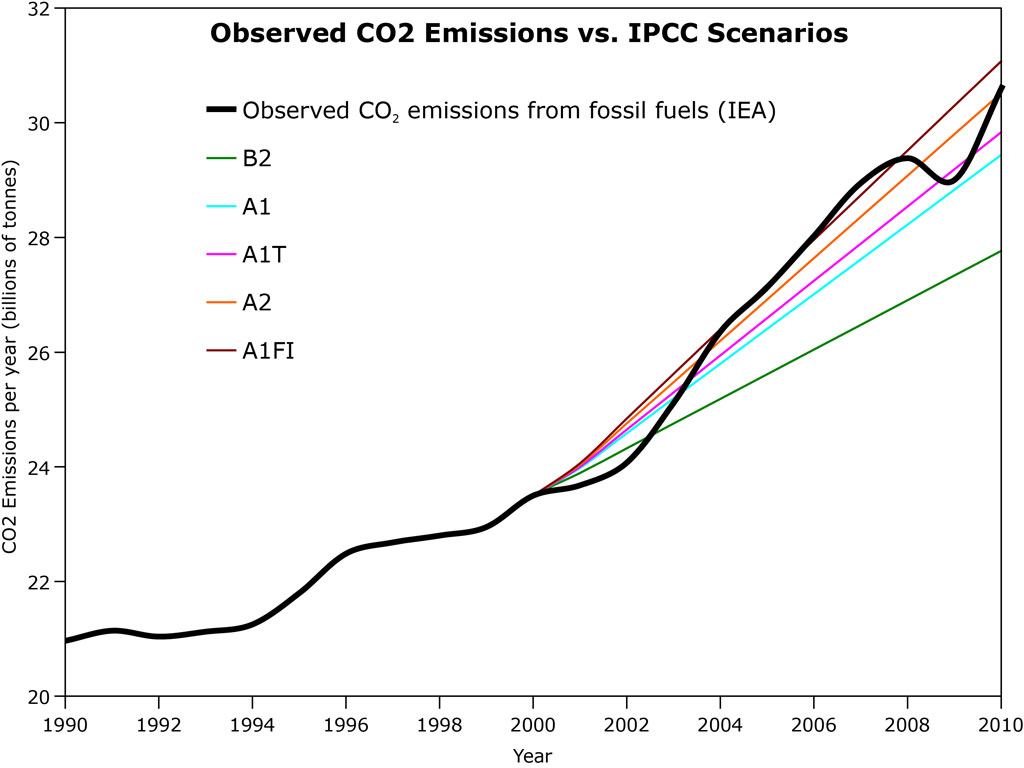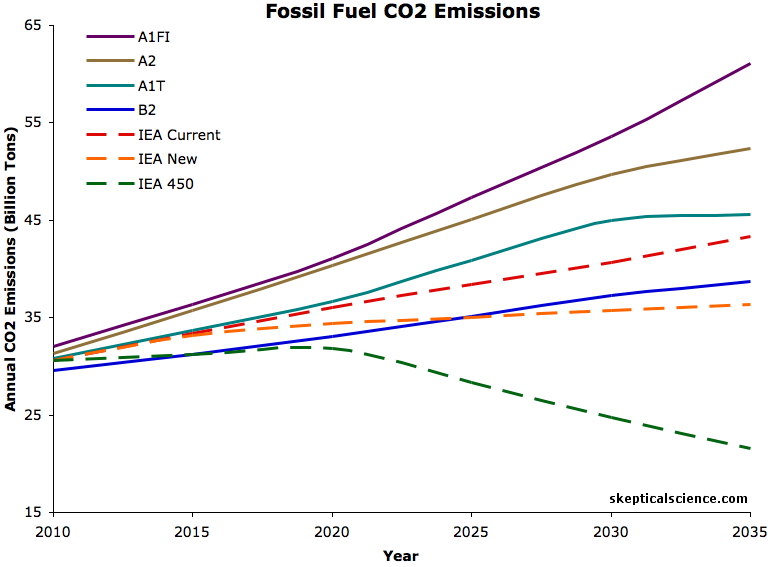Changing the Direction of the Climate
Posted on 1 December 2011 by dana1981, Andy Skuce
As Andy recently discussed, the International Energy Agency (IEA) has published the World Energy Outlook 2011 (WEO11), which incorporates the most recent data on global energy trends and policies, and investigates the economic and environmental consequences of three scenarios over the 2010 to 2035 time period:
- The New Policies Scenario. This is used as a reference case. It assumes that governments will follow through on the (non-binding) pledges that they have made to reduce emissions and deploy renewable energy sources.
- The 450 Scenario. This is an outcome-driven scenario, which lays out an energy pathway designed to limit the long-term concentration of greenhouse gasses to 450 ppm CO2 equivalent. Achieving this would provide a 50% chance of limiting global temperature increases to 2°C. Some climatologists, such as James Hansen, argue that a more aggressive 350 ppm target is required to avoid the possibility of “seeding irreversible catastrophic effects”.
- The Current Policies Scenario. This projection models a future in which only those climate and energy policies actually adopted in mid-2011 are incorporated.
The IEA focuses on CO2 emissions from energy production, as we'll see below. Their 450 Scenario proposes to keep CO2 equivalent (including all atmospheric greenhouse gases) concentrations in the vicinity of 450 ppm by very quickly reducing both non-fossil fuel CO2 emissions (i.e. reducing deforestation) and non-CO2 greenhouse gas emissions (i.e. methane), such that their emissions in 2020 are lower than today. However, the main focus of the report is on fossil fuel CO2 emissions.
IEA vs. IPCC Scenarios
There's some good news and some bad news in the IEA scenarios. The good news is that the IEA is more optimistic regarding future greenhouse gas emissions than the IPCC. Figure 1 compares cumulative emissions, the corresponding atmospheric CO2 concentration, and the resulting global surface warming at equilibrium (assuming a climate sensitivity of 3°C for doubled CO2) from the IEA and some of the IPCC SRES scenarios (for morre details on the IPCC SRES scenarios, see here).
Figure 1: Cumulative human fossil fuel CO2 emissions since 2001, resulting atmospheric CO2 concentration, and expected equilibrium surface warming for some IPCC SRES scenarios (solid lines) and the IEA scenarios (dashed lines). Horizontal reference lines are provided for 1 trillion tons of cumulative CO2 emissions, 450 ppmv CO2, and 2°C warming.
The IEA New scenario, which only requires that governments follow through on current pledges to reduce greenhouse gas emissions, is on par with IPCC scenario B2, which is expected to result in approximately 3°C warming above pre-industrial levels by 2100. The bad news is that this better than business-as-usual scenario will commit us to more than the 2°C 'danger limit' of global warming by 2035 (note this is eventual warming at equilibrium, which takes several decades, not warming by 2035).
How to Avoid Dangerous Warming
Figure 2 illustrates the annual fossil fuel CO2 emissions in the IPCC SRES and IEA emissions scenarios.
Figure 2: Annual CO2 emissions from fossil fuels for some IPCC SRES scenarios (solid lines) and the IEA scenarios (dashed lines).
All of the IPCC emissions scenarios, and the IEA Current and New scenarios depict fossil fuel CO2 emissions continuing to rise beyond 2035. In order to keep atmospheric CO2 concentrations below 450 ppm, the IEA creates a scenario in which those emissions peak in approximately 2018. The IEA provides a possible blueprint to achieve these emissions reductions in Figure 3.

Figure 3: World energy-related CO2 emissions abatement in the IEA 450 Scenario relative to the IEA New Policies Scenario.
The IEA suggests that nearly 50% of the emissions reductions should come from increased energy efficiency, and approximately 15% each from increased deployment of renewable energy technologies and carbon capture and storage (CCS) by 2035.
IEA Optimism
The IEA is also optimistic in that their 450 scenario allows for 984 billion tons of CO2 emissions from fossil fuels by 2035, and approximately 1.2 trillion tons by 2050. The Australian Climate Commission in its report The Critical Decade concluded that to have a 75% chance of avoiding 2°C warming, we only have a budget of 1 trillion tons of CO2 emissions between 2000 and 2050 (the IEA aims for 50% probability of limiting warming to 2°C).
Since the amount of warming caused by a given CO2 increase depends on the climate sensitivity, which has a fairly large range of uncertainty, it's possible that the IEA more optimistic emissions allowance will suffice in limiting global warming below the 'danger limit', although it reduces the probability of success. The IEA also belives that current committments are sufficient to keep us on track with IPCC SRES scenario B2, even though so far this century we're on pace for the much higher A2 scenario (Figure 4).

Figure 4: IEA emissions data through 2010 compared to the IPCC SRES emissions scenarios
We hope the IEA's optimism is warranted.
Path Changing Challenges
The WEO11 report notes some major challenges in achieving its 450 scenario:
Four-fifths of the total energy-related CO2 emissions permissible by 2035 in the 450 Scenario are already “locked-in” by our existing capital stock (power plants, buildings, factories, etc.). If stringent new action is not forthcoming by 2017, the energy-related infrastructure then in place will generate all the CO2 emissions allowed in the 450 Scenario up to 2035, leaving no room for additional power plants, factories and other infrastructure unless they are zero-carbon, which would be extremely costly.
In short, the IEA arrives at the same conclusion as The Critical Decade: because of the long lifespans of power plants, we are very quickly running out of time to take sufficient action to sufficiently reduce our CO2 emissions.
The report also notes that we're not helping the economy by delaying action - quite the contrary, as Skeptical Science has documented:
Delaying action is a false economy: for every $1 of investment avoided in the power sector before 2020 an additional $4.3 would need to be spent after 2020 to compensate for the increased emissions.
The Time to Change Direction is Now
The key quote from the WEO11 Executive Summary is:
If we don’t change direction soon, we’ll end up where we’re heading
As Figures 1 through 3 show, where we're headed is upward towards ever-more dangerous global warming, and where we need to go is downwards towards low fossil fuel consumption, low CO2 emissions, and stable atmospheric CO2 concentrations. In order to achieve this change in direction, we must take serious action to reduce our emissions immediately, because we're on track to lock in dangerous warming by 2017, and the IEA 450 scenario requires that CO2 emissions peak in 2018. Achieving an emissions peak within ~5 years requires that we begin enacting serious climate policy immediately.
The WEO11 foreward, written by Executive Director Maria van der Hoeven, sums up the situation very well:
The starkest decisions are those which must be taken without delay. I end by highlighting one area squarely in this category: the energy decisions necessary to contain the rise in the average global temperature to 2° Celsius. We read here of the way carbon emissions are already “locked-in” because of the nature of the plant and equipment which we continue to build. If we do not change course, by 2015 over 90% of the permissible energy sector emissions to 2035 will already be locked in. By 2017, 100%. We can still act in time to preserve a plausible path to a sustainable energy future; but each year the necessary measures get progressively tougher and viciously more expensive. So, let’s not wait any longer!
Realistically speaking, we're probably not going to be able to avoid the 2°C danger limit. But it's worth remembering that the danger limit is not a hard and fast threshold (though some, like James Hansen, believe it's far too high of a target). Even if we miss the target, it's critical that we exceed it by as little as possible. As Lonnie Thompson put it,
Sooner or later, we will all deal with global warming. The only question is how much we will mitigate, adapt, and suffer.
The longer we wait to implement serious mitigation, the more adaption and suffering will result. As van der Hoeven said, let's not wait any longer!































 Arguments
Arguments
































[dana1981] pre-industrial is 280, not 180ppm. But you're correct that there's virtually nil chance of us getting anywhere close to that, unless we invent some technology to remove massive quantities of CO2 from the atmosphere, or something.
The question is not warming or cooling, it's how much more warming.
[DB] For more info:
[DB] Conclusions of Archer 2009 (linked earlier):
Relevant Graphics:
- You can't win
- You can't break even unless it is very, very cold
- It never gets that cold
- You can't quit the game.
Getting the atmosphere back to where it was but at no net expense is trying to break even. You can only do that if you return to a snowball earth, and you can't do that.[DB] Fixed link.